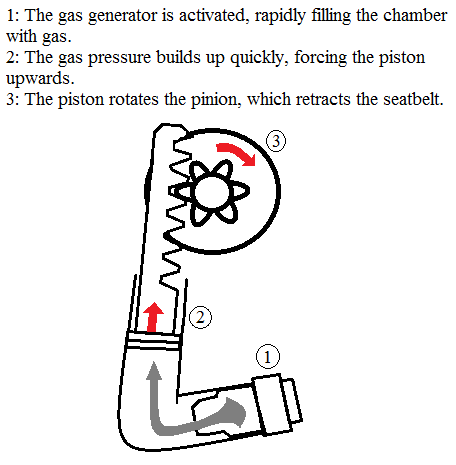Seatbelt Pretensioner
by Matthew Rentschler, Clemson Electrical Engineering Student
- Basic Description
-
The seat belt pretensioner is one of many actuators involved in a pre-crash safety system. The purpose of the pretensioner is to secure the occupant safely to their seat by tightening their seat belt, in order to reduce the risk of an injury. By holding the passenger tightly, this prevents them from impacting the steering wheel or dashboard, or from sliding out of their seat. This also improves the effectiveness of the airbag by allowing the passenger to impact the airbag in a controlled and predictable way. The concept of the seat belt being tightened originated in the 1950s, from a patent that used a device to secure pilots into their ejection seats before ejection. The Mercedes-Benz S-Class was the first automobile to implement the pretensioner. In more recent cars, the pretensioner works in conjunction with a force limiter to secure the passenger while also adjusting the slack throughout the crash, reducing the risk of chest compression and injury due to the seat belt. There are also systems that will tighten the belt during fast acceleration or deceleration, even in the absence of a crash, such as an evasive maneuver. There are various types of pretensioners, each with their own advantages and disadvantages. These different technologies are described below:
Mechanical Tensioner: The mechanical tensioner is the least common of the three technologies. It is connected to the belt by a very powerful spring, which is compressed and latched in place. In the case of an immediate acceleration/deceleration, the latch is unlocked and the spring is released, tightening the seat belt. The disadvantage to this particular technology is that very common actions can activate the pretensioner, such as putting on the seat belt quickly. It is also usually very difficult if not impossible to reset, meaning you would most likely need to replace it after it is activated.
Electrical Tensioner: Before the introduction of the pyrotechnic version, the electrical tensioner was the preferred option. Connected to the ECU, the pretensioner receives a signal from the accelerometer, sometimes the same sensor used for the airbag deployment system. When this sensor detects a sudden deceleration, it sends a signal which triggers a motor to quickly retract and tighten the belt. Because this technology is linked to a sensor somewhere else in the car, it does not have the problem of accidental triggering that the mechanical version does. Also, this type is the popular choice to use when the pretensioner is activated during an evasive maneuver due to its ability to be reused multiple times.
Pyrotechnic Tensioner: Currently, the pyrotechnic pretensioner is the most common version found in modern cars. This is because they are considered the most reliable of the three. The pyrotechnic tensioner is also connected to the ECU, and uses an accelerometer found elsewhere in the vehicle. When it receives an electric pulse, an explosive charge is used to set off a gas generator. The volume of gas applies pressure to a mechanical linkage with pulls on the seat belt. The benefit of this technology is that it is currently the fastest option. However, the downside of this one is that it is a one-time use, meaning it needs to be replaced after it is activated.

- Manufacturers
- Autoliv, Far Europe, Takata, TRW
- For More Information
- [1] Seat Belt Pre Tensioner, WhyHighEnd.com, 2010.
- [2] Seatbelt Pretensioners, WikiCars.
- [3] What is the Purpose of a Seatbelt Pretensioner?, Akweli Parker, HowStuffWorks.com.
- [4] Pre-tensioner and Force Limiter - Toyota New Zealand, YouTube, July 4, 2011.
- [5] Seat Belt Pre-Tensioner, YouTube, Jan. 4, 2013.
|

